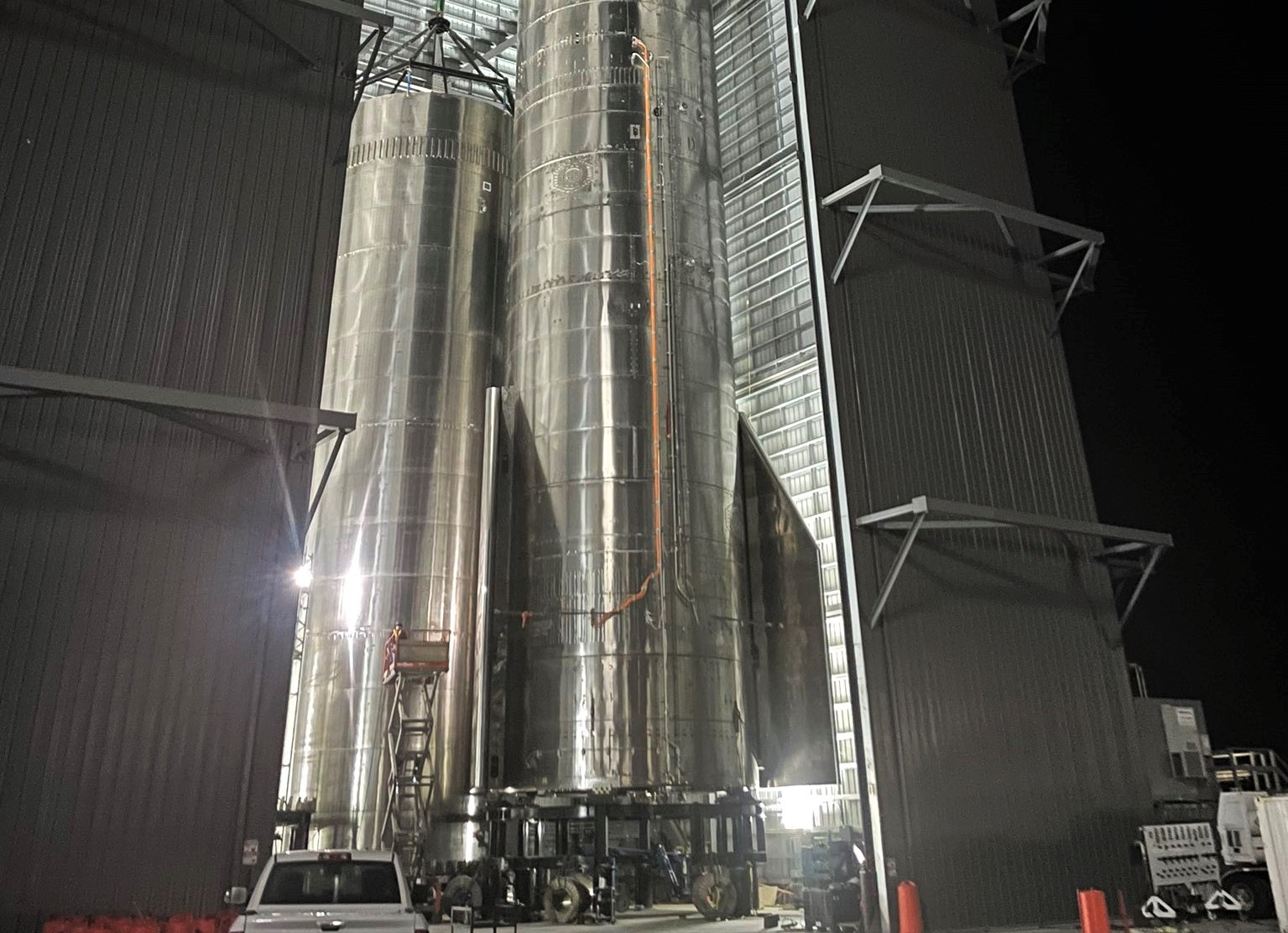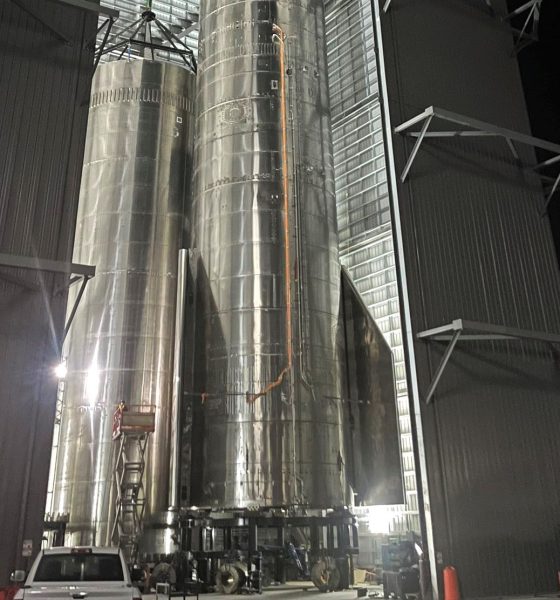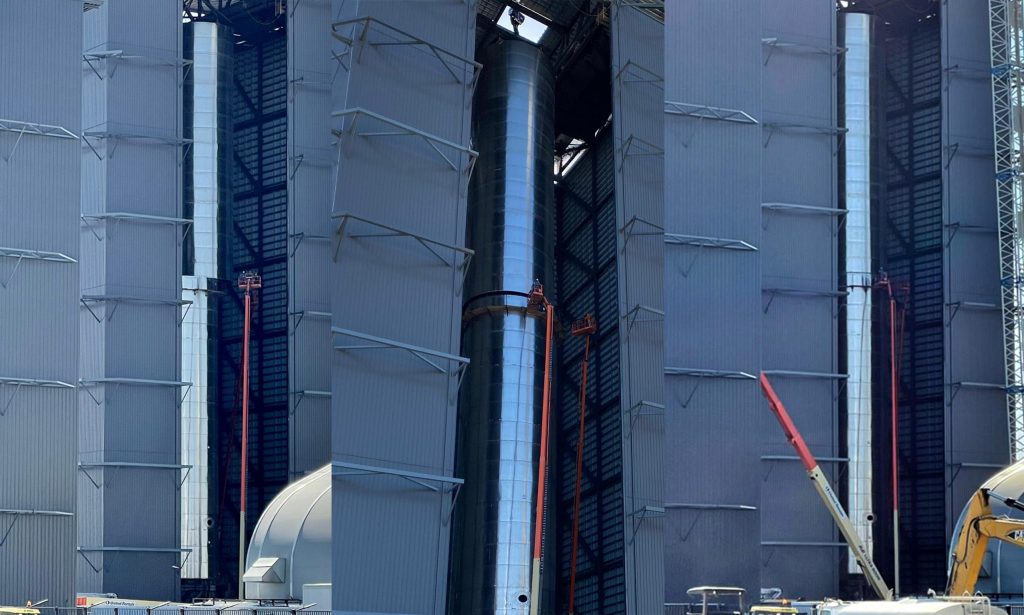

News
Elon Musk says SpaceX’s second Starship booster prototype is almost finished
SpaceX CEO Elon Musk says that the second Starship booster prototype is “almost done” and has revealed that work on the first flightworthy booster has yet to begin.
For unknown reasons, SpaceX has recently changed the naming scheme for Starship and Super Heavy boosters. The booster SpaceX is currently assembling in Boca Chica has been referred to as “Booster 2” by Musk himself but, according to NASASpaceflight, is internally known as Booster 3 or B3, replacing its former Booster Number 3 (BN3) designation.
Regardless, SpaceX began stacking the Super Heavy booster prototype now known as B3 in mid-May. Around six weeks later, 23 or 24 rings have been stacked to create a partially finished prototype 9m (~30 ft) wide and approximately 42m (~140 ft) tall.
Just like Super Heavy ‘pathfinder’ BN1, which was scrapped almost the instant it reached its full height last March, Booster 3 appears to destined to stand 36 rings – 65m (~215 ft) – tall once complete. While drastically oversimplifying the process of vertically assembling the largest rocket booster ever built, that means that Super Heavy B3 is just shy of two-thirds (~65%) complete.
By simply averaging the time it’s taken for SpaceX to stack B3 to a height of 42 meters, the booster could reach its full height around three weeks from now (July 15th, give or take a week). For the most part, the most challenging and unfamiliar parts of Super Heavy B3 manufacturing and assembly have already been completed. Relative to Starship, which SpaceX has now built more than half a dozen prototypes of, Super Heavy is just a stretched Starship with no flaps, no nosecone, a far more complex engine section, and a forward dome section that needs to support car-sized grid fins.
Super Heavy’s larger propellant tanks also require a methane transfer tube – used to carry methane through the booster’s lower liquid oxygen tank – more than twice as tall as anything built for Starship. By all appearances, that ~35m (~115 ft) tall transfer tube has already been safely installed inside B3’s incomplete tanks. Around June 14th, B3’s lower two-thirds were effectively completed when its LOx tank stack was mated to the booster’s 29-Raptor engine section.

Outfitted with complex structural modifications to support massive grid fins and the first advanced ‘hot gas’ maneuvering thrusters ever spotted in public, Booster 3’s forward dome is already in the process of being welded to a stack of three steel rings. Once complete, the rest of Super Heavy B3 integration is fairly simple as far as rocket assembly goes and will require four more welding operations. Like BN1, there’s a good chance that SpaceX will mate Booster 3’s upper (methane) tank separately and then install the ~24m (~80 ft) tall, 13-ring section on top of the LOx stack to effectively complete the booster’s main structure
Of course, after the structure is complete, SpaceX will still need to finish plumbing, wiring, and generally outfitting a Super Heavy booster for the first time ever. Finally, while it remains to be seen just how finished B3 will actually find itself before heading to the launch pad, that process could also involve installing and testing four massive steel grid fins and, most importantly, up to 29 Raptor engines – a figure only beaten by the Soviet Union’s ill-fated N1 rocket.
Perhaps most significantly, Musk also revealed that B3 is not the Super Heavy booster assigned to Starship’s first orbital launch attempt, meaning that SpaceX will have to complete Booster 3 testing and build Booster 4 before that orbital test flight can occur. Given that Booster 3 assembly is on track to take more than nine weeks, Starship’s first orbital launch attempt is thus unlikely to happen before late August or September.

News
Tesla FSD fleet is nearing 7 billion total miles, including 2.5 billion city miles
As can be seen on Tesla’s official FSD webpage, vehicles equipped with the system have now navigated over 6.99 billion miles.

Tesla’s Full Self-Driving (Supervised) fleet is closing in on almost 7 billion total miles driven, as per data posted by the company on its official FSD webpage.
These figures hint at the massive scale of data fueling Tesla’s rapid FSD improvements, which have been quite notable as of late.
FSD mileage milestones
As can be seen on Tesla’s official FSD webpage, vehicles equipped with the system have now navigated over 6.99 billion miles. Tesla owner and avid FSD tester Whole Mars Catalog also shared a screenshot indicating that from the nearly 7 billion miles traveled by the FSD fleet, more than 2.5 billion miles were driven inside cities.
City miles are particularly valuable for complex urban scenarios like unprotected turns, pedestrian interactions, and traffic lights. This is also the difference-maker for FSD, as only complex solutions, such as Waymo’s self-driving taxis, operate similarly on inner-city streets. And even then, incidents such as the San Francisco blackouts have proven challenging for sensor-rich vehicles like Waymos.
Tesla’s data edge
Tesla has a number of advantages in the autonomous vehicle sector, one of which is the size of its fleet and the number of vehicles training FSD on real-world roads. Tesla’s nearly 7 billion FSD miles then allow the company to roll out updates that make its vehicles behave like they are being driven by experienced drivers, even if they are operating on their own.
So notable are Tesla’s improvements to FSD that NVIDIA Director of Robotics Jim Fan, after experiencing FSD v14, noted that the system is the first AI that passes what he described as a “Physical Turing Test.”
“Despite knowing exactly how robot learning works, I still find it magical watching the steering wheel turn by itself. First it feels surreal, next it becomes routine. Then, like the smartphone, taking it away actively hurts. This is how humanity gets rewired and glued to god-like technologies,” Fan wrote in a post on X.
News
Tesla starts showing how FSD will change lives in Europe
Local officials tested the system on narrow country roads and were impressed by FSD’s smooth, human-like driving, with some calling the service a game-changer for everyday life in areas that are far from urban centers.

Tesla has launched Europe’s first public shuttle service using Full Self-Driving (Supervised) in the rural Eifelkreis Bitburg-Prüm region of Germany, demonstrating how the technology can restore independence and mobility for people who struggle with limited transport options.
Local officials tested the system on narrow country roads and were impressed by FSD’s smooth, human-like driving, with some calling the service a game-changer for everyday life in areas that are far from urban centers.
Officials see real impact on rural residents
Arzfeld Mayor Johannes Kuhl and District Administrator Andreas Kruppert personally tested the Tesla shuttle service. This allowed them to see just how well FSD navigated winding lanes and rural roads confidently. Kruppert said, “Autonomous driving sounds like science fiction to many, but we simply see here that it works totally well in rural regions too.” Kuhl, for his part, also noted that FSD “feels like a very experienced driver.”
The pilot complements the area’s “Citizen Bus” program, which provides on-demand rides for elderly residents who can no longer drive themselves. Tesla Europe shared a video of a demonstration of the service, highlighting how FSD gives people their freedom back, even in places where public transport is not as prevalent.
What the Ministry for Economic Affairs and Transport says
Rhineland-Palatinate’s Minister Daniela Schmitt supported the project, praising the collaboration that made this “first of its kind in Europe” possible. As per the ministry, the rural rollout for the service shows FSD’s potential beyond major cities, and it delivers tangible benefits like grocery runs, doctor visits, and social connections for isolated residents.
“Reliable and flexible mobility is especially vital in rural areas. With the launch of a shuttle service using self-driving vehicles (FSD supervised) by Tesla in the Eifelkreis Bitburg-Prüm, an innovative pilot project is now getting underway that complements local community bus services. It is the first project of its kind in Europe.
“The result is a real gain for rural mobility: greater accessibility, more flexibility and tangible benefits for everyday life. A strong signal for innovation, cooperation and future-oriented mobility beyond urban centers,” the ministry wrote in a LinkedIn post.
News
Tesla China quietly posts Robotaxi-related job listing
Tesla China is currently seeking a Low Voltage Electrical Engineer to work on circuit board design for the company’s autonomous vehicles.

Tesla has posted a new job listing in Shanghai explicitly tied to its Robotaxi program, fueling speculation that the company is preparing to launch its dedicated autonomous ride-hailing service in China.
As noted in the listing, Tesla China is currently seeking a Low Voltage Electrical Engineer to work on circuit board design for the company’s autonomous vehicles.
Robotaxi-specific role
The listing, which was shared on social media platform X by industry watcher @tslaming, suggested that Tesla China is looking to fill the role urgently. The job listing itself specifically mentions that the person hired for the role will be working on the Low Voltage Hardware team, which would design the circuit boards that would serve as the nervous system of the Robotaxi.
Key tasks for the role, as indicated in the job listing, include collaboration with PCB layout, firmware, mechanical, program management, and validation teams, among other responsibilities. The role is based in Shanghai.
China Robotaxi launch
China represents a massive potential market for robotaxis, with its dense urban centers and supportive policies in select cities. Tesla has limited permission to roll out FSD in the country, though despite this, its vehicles have been hailed as among the best in the market when it comes to autonomous features. So far, at least, it appears that China supports Tesla’s FSD and Robotaxi rollout.
This was hinted at in November, when Tesla brought the Cybercab to the 8th China International Import Expo (CIIE) in Shanghai, marking the first time that the autonomous two-seater was brought to the Asia-Pacific region. The vehicle, despite not having a release date in China, received a significant amount of interest among the event’s attendees.








